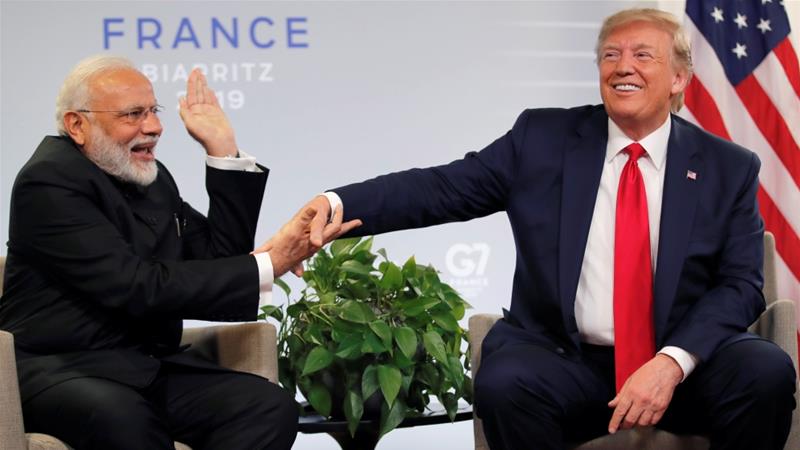
Trump and Modi: Commonalities that have forged their camaraderie
Despite coming from vastly different backgrounds - Donald Trump is the son of a property tycoon while Narendra Modi is a descendant of a poor tea-seller, both share uncanny similarities that have seen them forge a close personal bond, analysts say.

Despite coming from vastly different backgrounds – Donald Trump is the son of a business tycoon while Narendra Modi is the son of a poor tea-seller – both the world leaders share uncanny similarities that have seen them forge a close personal bond, analysts say.
Both are Alpha personalities, both love crowds, both like to appeal directly to their audiences without any aide, both have their own unique approach the way they practise politics and both wish to be world leaders.
They speak their mind, and wear nationalism on their sleeves, have ambitions to make their nations “great again”, and both go by their own intuitions rather than waiting for advice from their officials and often because of this they go wrong with facts.
Ahead of the American leader’s first official visit to India, which begins in Modi’s home state of Gujarat on Monday, the world’s biggest democracy has gone out of its way to showcase the chemistry between them.
In Gujarat’s capital Ahmedabad, large billboards with the words “two dynamic personalities, one momentous occasion” and “two strong nations, one great friendship” have gone up across the city.
“There’s a lot that Trump and Modi share in common, and not surprisingly these convergences have translated into warm chemistry between the two,” Michael Kugelman of the Washington-based Wilson Center told AFP.
Related news: US President lands in Ahmedabad with wife, daughter
“Personality politics are a major part of international diplomacy today. The idea of closed-door dialogue between top leaders has often taken a backseat to very public and spectacle-laden summitry.”
Since assuming the top political office in their respective countries — Modi in 2014 and Trump in 2017 — the two men have been regularly compared to each other.
Trump, 73, and Modi, 69, both command crowds of adoring flag-waving supporters at rallies. A virtual cult of personality has emerged around them, with their faces and names at the centre of their political parties’ campaigns.
Nationalist, protectionist
A focus of Trump’s administration has been his crackdown on migrants, including a travel ban that affects several Muslim-majority nations, among others, while critics charge that Modi has sought to differentiate Muslims from other immigrants through a contentious citizenship law that has sparked protests.
Both promote their countries’ nationalist and trade protectionist movements — Trump with his “America First” clarion call and Modi with his “Make in India” mantra.
And while they head the world’s largest democracies, critics have described the pair as part of a global club of strongmen that includes Russia’s Vladimir Putin and Brazil’s Jair Bolsonaro.
“There are many qualities that Trump and Modi share — a love for political grandstanding and an unshakable conviction that they can achieve the best solutions or deals,” former Indian diplomat Rakesh Sood told AFP.
Modi and Trump have sought to use their friendship to forge closer bonds between the two nations, even as they grapple with ongoing tensions over trade and defence.
Related news: Motera stadium: Facts about Trump’s first stop in Ahmedabad
Despite sharing many similarities in style and substance, analysts say there are some notable differences between the pair.
Modi is an insider who rose through the ranks of the Bharatiya Janata Party after starting out as a cadre in the Rashtriya Swayamsevak Sangh.
Trump is a businessman and a political outsider who has in some sense taken over the Republican Party.
“Modi is a more conventional leader than is Trump in that he hasn’t sought to revolutionise the office he holds in the way that Trump has,” said Kugelman, a long-time observer of South Asian politics.
He added that genuine personal connections between leaders of both countries have helped to grow the partnership.
“George Bush and Manmohan Singh, Barack Obama and Singh, Obama and Modi, now Modi and Trump — there has been strong chemistry in all these pairings that has clearly helped the relationship move forward,” he added.
Trump has also stood by the Indian leader during controversial decisions, including his revocation of autonomy for Kashmir and his order for jets to enter Pakistani territory following a suicide bombing.
Analysts said the leaders would use the visit to bolster their image with voters.
A mega “Namaste Trump” rally in Ahmedabad on Monday will be modelled after the ‘Howdy, Modi’ Houston extravaganza last year when the Indian leader visited the US and the two leaders appeared before tens of thousands of Indian-Americans at a football stadium.
Related news: From Ahmedabad to Agra: All about 34 hours of Trump in India
“The success of this visit… will have a positive impact on his (Trump’s) re-election campaign and the people of Indian origin who are voters in the US — a majority of them are from Gujarat,” former Indian diplomat Surendra Kumar told AFP.
“On the Indian side, the fact that Prime Minister Modi… (shares) such warmth, bonhomie and informality with the most powerful man on Earth adds to his stature… as well as with hard-core supporters.”
(With inputs from agencies.)

